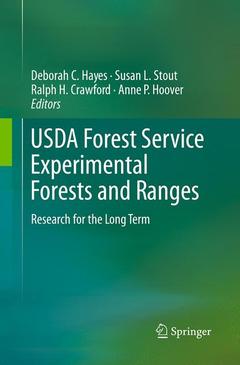USDA Forest Service Experimental Forests and Ranges, Softcover reprint of the original 1st ed. 2014 Research for the Long Term
Coordonnateurs : Hayes Deborah C., Stout Susan L., Crawford Ralph H., Hoover Anne P.

Part I. Introduction.- Deputy Chief of FS Research, Raphael Zon, Memo to Forest Service Chief Pinchot, May 6, 1908.- Map of USDA Forest Service Experimental Forest and Ranges.- Chapter 1. A Grand Experiment: USDA Forest Service Experiment Forest and Ranges.- Chapter 2. Forest Service Experimental Forests and Long-term Data Sets: Stories of their Meaning to Station Directors.- Part II. Research Trajectories in Forest Ecology, Management, and Silviculture for Conifers.- Chapter 3. The Value of Old Forests: Lessons from the Forest Service Reynolds Research Natural Areas.- Chapter 4. Restoring a legacy: Long-leaf pine research at the Forest Service Escambia Experimental Forest.- Chapter 5. Northern Conifer Research: Multiple Species and Multiple Values.- Chapter 6. Fire and Thinning Research on Forest Service Blacks Mountain Experimental Forest.- Part III. Research Trajectories in Forest Ecology, Management, and Silviculture for Hardwoods.- Chapter 7. Uneven-aged management after a half-century of research on the Forest Service Fernow Experimental Forest in West Virginia.- Chapter 8. An Alternative to Clearcutting: A Partnership between Scientists on the Fernow Experimental Forest and Land Managers on the Monongahela National Forest.- Chapter 9. Development of the Selection System in Northern Hardwood Forests: An 80 Year Research Legacy with Impacts across Borders.- Part IV. Research Trajectories in Wildlife, Fauna, Insects.- Chapter 10, The Starkey Experimental Forest and Range: Long-Term Research to meet the needs of Managers.- Chapter 11. Evolution of a Short-Term Study of Lodgepole Pine Dwarf Mistletoe Vectors that turned Into a Long-Term Study of the Remarkable Gray Jay on the Fraser Experimental Forest, Co, 1982-2009.- Chapter 12. Subterranean Termite Control Examinations on Current And Former Experimental Forests and Ranges.- Part V. Research Trajectories in Forest and Range Hydrology, Biogeochemistry,Soils and Ecosystem Science.- Chapter 13. A Cycle of Research at Fort Valley, Arizona, the First Forest Service Research Experiment Station.- Chapter 14. Contributions of Studies on Experimental Forests to Hydrology and Watershed Management.- Chapter 15. A History of Watershed Research in Experimental Forests of the Interior Highlands.- Chapter 16. Research Related to Roads in USDA FS Experimental Forests.- Chapter 17. The Role of Experimental Forests and Ranges in the Development of Ecosystem Science and Biogeochemical Cycling Research.- Chapter 18. Six Decades of Soil and Ecosystem Research at USDA FS Calhoun Experimental Forest.- Chapter 19. Disturbance Ecology and Tropical Forest Management at the Luquillo Experimental Forest.- Chapter 20. The Acid Deposition Trajectory.- Part VI. Research Trajectories in Fire.- Chapter 21. From Fighting Bad Fires to Fire-Dependent Ecosystems.- Chapter 22. The Fire Research Program at the Silas Little Experimental Forest, New Lisbon, New Jersey.- Part VII. Intersite and Network Trajectories.- Chapter 23. The Key Roles of Four Experimental Forests in the Long Term Soil Productivity International Research Program.- Chapter 24. The Role of the Hydro Database in Developing the Water Hydrology and Chemistry Network.- Part VIII. Emerging Human Dimension Research Trajectories.- Chapter 25. Social Science Research and Experimental Forests and Ranges.- Chapter 26. Public Use and Citizen Outreach in Experimental Forests and Ranges.- Chapter 27. Expanding the Vision of Experimental Forests to Urban Areas.- Part IX. The Future.- Chapter 28. The Future of USDA Forest Service Experimental Forests and Ranges.
Ouvrage de 672 p.
15.5x23.5 cm
Ouvrage de 672 p.
15.5x23.5 cm



